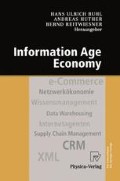Zusammenfassung
Unsere Anforderungen bleiben während eines Entwicklungsprojektes weitgehend stabil, da wir die eigentlichen Kundenprobleme systematisch ermittelt und priorisiert haben und frühzeitig eine klare Produktvision und -abgrenzung existierte. Natürlich gibt es auch Änderungen. Diese werden in einem kontrollierten, für alle Beteiligten transparenten Prozess in die Umsetzung geführt. Das Projektteam kann sich auf die Detaillierung und Umsetzung der Anforderungen konzentrieren. Es existieren klare Auftraggeber-/Auftragnehmer-Strukturen zwischen Kunden, Produktmanagern und Entwicklung. Da wir ein kontinuierliches Risiko-und Umsetzungsmanagement verfolgen, kennen wir jeweils den aktuellen Projektstatus und können aktiv Problemen entgegenwirken. Das Verhältnis zwischen Entwicklung, Kunden und Anwendern ist gut, alle Gruppen arbeiten eng zusammen. a (ein zufriedener IT-Leiter)
Access this chapter
Tax calculation will be finalised at checkout
Purchases are for personal use only
Preview
Unable to display preview. Download preview PDF.
Literatur
Beck, K.: Extreme Programming Explained: Embrace Change. Addison Wesley 1999
Cockbum, A.: Crystal Clear: A Human-Powered Methodology for Small Teams. Addison-Wesley (erscheint voraussichtlich 2002; Online-Version siehe mem–bers.aol.com/humansandt/crystal/clear)
Davis, A.M.: Software Requirements. Objects, Functions, & States. Prentice Hall 1993
European Software Process Improvement Traning Initiative (Hrsg.): User Survey Report. ESPITI 1995
Gause, D.C.; Weinberg, G.M.: Software Requirements. Anforderungen erkennen, verstehen und erfüllen. Hanser 1993
Kräft, D.; Fabian, D.: S-INI-Prozess: Von der Idee zur Anwendung. In: update 3/99, S. 21–23
Kugeler, M.; Vieting, M.: Gestaltung einer prozessorientiert(er)en Aufbauorganisation. In: Becker, J.; Kugeler, M.; Rosemann, M. (Hrsg.): Prozessmanagement. Springer 2000, S. 187–232
Leffingwell, D.; Widrig, D.: Requirements Management. A Unified Approach. Addison-Wesley 1999
Martin, J.N.; Hahill, A.T. (Hrsg.): Systems Engineering Guidebook: A Process for Developing Systems and Products. Prentice Hall 1996
Österle, H.: Business Engineering, Prozess-und Systementwicklung, Band l: Entwurfstechniken. Springer 1995
Österle, H.: Business Engineering, Auf dem Weg zum Unternehmen des Informationszeitalters. Springer 2000
Pohl, K.: Process-Centered Requirements Engineering. Wiley 1996
Pohl, K.: Continuous Documentation of Information System Requirements. Habilitation, RWTH Aachen 1999
Robertson S., Robertson J.: Mastering the Requirements Process. Addison Wesley 1999
Rupp, C.: Requirements Engineering und —Management. Hamer 2001
Sawyer, P., Sommerville, I.; Viller, S.: Requirements Process Improvement Through the Phased Introduction of Good Practice. In: Software Process - Improvement and Practice 1 (1997) 3, S. 19–34
Simon, H. A.: The Sciences of the Artificial. 2. Auflage. MIT Press 1985
Standish Group (Hrsg.): The Scope of Software Development Project Failures. CHAOS-Report. Standish Group 1995
Schienmann, B.; Strassenburg, S.; Schelling, B.: Erfolgreiches Anforderungsmanagement. In: Betriebswirtschaftliche Blätter 49 (2000) 12, S. 597–602
Schienmann, B.: Anforderungsmanagement in der Sparkassenorganisation. In:. Mayr, H.C.; Hesse, W.; Oberweis, A.; Kop, Ch. (Hrsg.): Software-Management 2000. Proc. Software Management’2000. Bd. 149. Wien: OCG 2000, S. 133–149
Stevens, R.; Brook, P.; Jackson, K.; Arnold, S: Systems Engineering. Coping with Complexity. Prentice Hall 1998
Wiegers, K.E.: Software Requirements. Microsoft Press 1999
Author information
Authors and Affiliations
Editor information
Editors and Affiliations
Rights and permissions
Copyright information
© 2001 Springer-Verlag Berlin Heidelberg
About this paper
Cite this paper
Schienmann, B., Pohl, K. (2001). Die drei Bereiche des kontinuierlichen Anforderungsmanagements. In: Buhl, H.U., Huther, A., Reitwiesner, B. (eds) Information Age Economy. Physica, Heidelberg. https://doi.org/10.1007/978-3-642-57547-1_55
Download citation
DOI: https://doi.org/10.1007/978-3-642-57547-1_55
Publisher Name: Physica, Heidelberg
Print ISBN: 978-3-642-63300-3
Online ISBN: 978-3-642-57547-1
eBook Packages: Springer Book Archive

